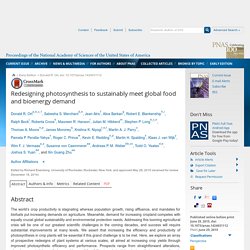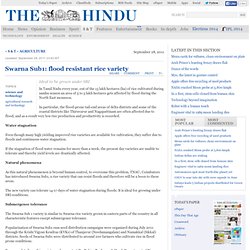

Redesigning photosynthesis to sustainably meet global food and bioenergy demand. Author Affiliations Edited by Richard Eisenberg, University of Rochester, Rochester, New York, and approved May 28, 2015 (received for review December 18, 2014) Abstract The world’s crop productivity is stagnating whereas population growth, rising affluence, and mandates for biofuels put increasing demands on agriculture.

Meanwhile, demand for increasing cropland competes with equally crucial global sustainability and environmental protection needs. Addressing this looming agricultural crisis will be one of our greatest scientific challenges in the coming decades, and success will require substantial improvements at many levels. Footnotes Author contributions: D.R.O., S.S.M., J.A., A.B., R.E.B., R.B., R.C., M.R.H., J.M.H., S.P.L., T.A.M., J.M., K.K.N., M.A.J.P., P.P.P. Freely available online through the PNAS open access option. Swarna Sub1: flood resistant rice variety. In Tamil Nadu every year, out of the 15 lakh hectares (ha) of rice cultivated during samba season an area of 3 to 5 lakh hectares gets affected by flood during the North East monsoon.

In particular, the flood-prone tail-end areas of delta districts and some of the coastal districts like Thiruvarur and Nagapattinam are often affected due to flood, and as a result very low rice production and productivity is recorded. Water stagnation Even though many high yielding improved rice varieties are available for cultivation, they suffer due to floods and continuous water stagnation. If the stagnation of flood water remains for more than a week, the present day varieties are unable to tolerate and thereby yield levels are drastically affected. Natural phenomena As this natural phenomenon is beyond human control, to overcome this problem, TNAU, Coimbatore has introduced Swarna Sub1, a rice variety that can resist floods and therefore will be a boon to these areas.
Submergence tolerance. Central information website for the global seed industry. New Delhi, India September 14, 2010 Farmers cultivating rice on 12 million hectares of flood-prone areas in India are planting flood-tolerant rice varieties at unprecedented rates, thanks to faster seed multiplication, targeted dissemination, and linking of partners.

Dr. Umesh Singh, senior scientist at the International Rice Research Institute (IRRI), said, “Earlier, we only provided and field-tested IRRI rice lines that were tolerant of flooding. Now, we assist government agencies and private seed companies to multiply and distribute seeds to farmers at a faster pace.” Field-testing a rice variety normally takes 4–5 years before it is released and another 2–3 years before it reaches farmers. Even before the seeds are released, different research institutions are already multiplying these seeds,” Dr. Under submergence, Swarna-Sub1 provides a yield advantage of about one ton per hectare over Swarna,” Dr.
“We are hoping that Swarna-Sub1 will reach the same status in only five years,” Dr. Boeing reveals “the biggest breakthrough in biofuels ever”- Plants that can be grown in the desert with salt water, easily broken into carbohydrates. : science. This plant has been genetically engineered to provide mood lighting. Food. Experimental Ebola Treatment Produced In Genetically Modified Plants.
Voracious Worm Evolves to Eat Biotech Corn Engineered to Kill It - Wired Science. Corn rootworm on the roots of a corn plant. Image: Sarah Zukoff/Flickr One of agricultural biotechnology’s great success stories may become a cautionary tale of how short-sighted mismanagement can squander the benefits of genetic modification. After years of predicting it would happen — and after years of having their suggestions largely ignored by companies, farmers and regulators — scientists have documented the rapid evolution of corn rootworms that are resistant to Bt corn.
Until Bt corn was genetically altered to be poisonous to the pests, rootworms used to cause billions of dollars in damage to U.S. crops. Named for the pesticidal toxin-producing Bacillus thuringiensis gene it contains, Bt corn now accounts for three-quarters of the U.S. corn crop.